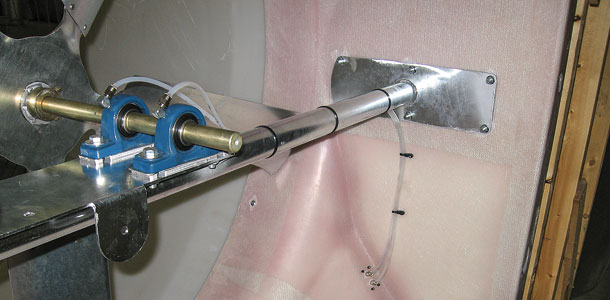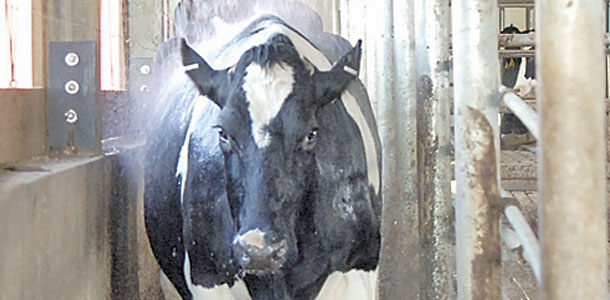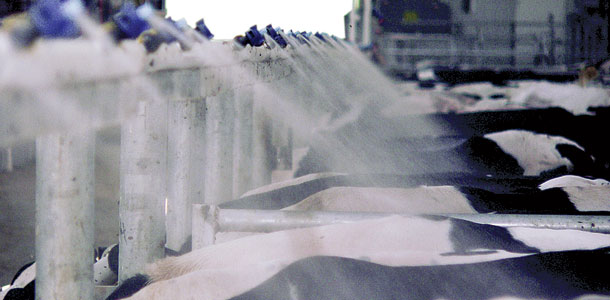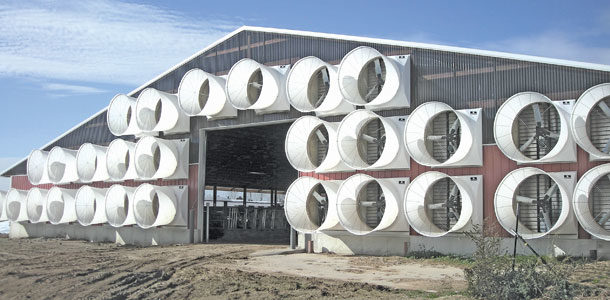Setting a plan, fan selection, applying soaking, evaporative cooling or misting are all critical processes within your heat-abatement strategy, but let’s not forget the important role of system maintenance in a proper heat-abatement program.
As we head into summer, most dairies are aware of the benefits of cow cooling and how proper cooling systems and heat-abatement plans can add profit back into the bottom line.
In the past, we have provided you with the resources that support the value of heat abatement, how and where to apply your strategies, as well as tools such as mobile applications you can download to help you determine the heat-stress levels within your operation and suggestions to alleviate the stress.
However, the best of plans are no good if your system is not performing to the best of its ability. That is why maintenance is key.
The ventilation system within your dairy can consume about 20 to 25 percent of the energy used. Those systems you have invested in and implemented into your heat-abatement plan are critical to guarantee good herd health, milk production and conception rates. Therefore, it is critical you maintain them and keep them working properly.
Field studies that measured fan performance ratings have shown airflow rates that run between 40 and 80 percent of the BioEnvironmental and Structural Systems (BESS) lab values.
If you have established your heat-abatement plan based on BESS lab performance – which is highly recommended – you are simply not delivering the adequate ventilation needed to be effective or reach your goals. So what is the culprit robbing your system from being as effective as it once was? The answer is maintenance.
Troubleshooting
Since poor maintenance can reduce efficiencies, you should follow the manufacturer’s recommendations for cleaning and lubricating fans.

Conduct a visual inspection on a daily basis by inspecting the fans’ orientation. One of the biggest issues I see on dairies is misaligned fans.
You would be surprised by how many barns I walk into with fans that are not properly positioned to cool cows. In some cases, the fans are pushing air 4 feet above the cows; other times, they are tilted directly down after being hit by farm machinery. Make sure the fans move air over the backs of the cows.
In bedding locations, remember the cow will be in a resting position; thus, the targeted cooling area is much lower than when they are at the feeding lines. Look for fan damage that has occurred by farm equipment and other third-party culprits such as wind, birds and vibrations.
Bent guards, damaged blades and loose mounting brackets are most common. A quick fix will save you time, labor and costly repairs or fan replacement. Inspect sprinkler nozzles and fix those that are plugged or not working effectively, as well as damaged or broken water lines.
If the barn uses evaporative cooling, look along the distribution pipe for plugged holes and even distribution on the pads. Allow the pads to dry out completely once a day to minimize algae growth. Remember, your pads will last longer if you minimize the number of wet and dry cycles.
Dairymen who conduct a visual inspection every day while performing other tasks within the facility eliminate maintenance issues quickly by making the system as productive as possible.
Over time, it becomes routine; the little issues become fewer, and the big issues are prevented before they can occur. Many dairies keep an inventory of spare replacement parts on hand with minimum quantities and order points to ensure parts are readily available anytime maintenance is performed.
Turn off the electricity. Once you have done your daily inspection, note all of the adjustments and then start out by always turning off the electricity at the circuit breaker or fuse box before you do any maintenance, adjustments or repairs.
A lock-out procedure should be in place. (A lock-out procedure is a process that allows only the individual performing maintenance on the system to place a lock on the service panel door or circuit box. This will prevent anyone else from accessing the electrical box and inadvertently turning on the system while work is being performed.)

Schedule maintenance monthly or as recommended by the manufacturer. This should include recalibrating your thermostats. Dust and dirt will build up on the sensors, which may give incorrect or delayed readings.
A simple cleaning will get them to accurately direct your cooling system. If you have dust and dirt buildup on the fan blades, it will reduce your performance. Use a stiff, nylon-bristled brush or a vacuum brush attachment to loosen dirt and wipe them down.
If you use a high-pressure washer, avoid damage to the blades. A bent or cracked blade will not only reduce fan life and performance, but it can potentially be hazardous as well. A pressure washer can be used on the housing, shutters, hoods and guards.
The fan motor should be totally enclosed to prevent damage from occurring from the water and dirt being forced into the windings and bearings. Dirty blades, shutters and inlets with just one-eighth inch of buildup can reduce your performance by as much as 35 percent. Keeping them clean can get your system back to the specifications you need to provide effective cooling.
Lubricate the bearings and motors as needed. Note, remote lubrication kits can make this job much easier and reduce labor cost significantly; in most cases, it is well worth the up-front cost. Follow manufacturer’s guidelines, but keep in mind that oil attracts dirt. Graphite attracts less dirt and holds up longer for better results.
Tighten belts. If you do not have an automatic belt-tightening system on your fan, look for slippage or loose belts. This alone can reduce air flow by 25 to 35 percent. Loose or slipping belts are easy to forget, but they can certainly be costly as your fan motor is operating at full capacity but only emitting partial performance.
When this happens, you pay for the electrical usage, but you do not see the benefit of the uptick in milk production, conception rates or herd health. It may also reduce the life of the motor, as it is running above specified RPMs.

Wet walls or evaporative cooling systems need additional care. Gently brush or hose down the face of the pads to remove any built-up dirt or water deposits. It is advised to drain and flush the system once a month, particularly if using a stand-off kit.
Water quality will also play a factor as to the amount of service your system will need. Contaminants, fertilizers and harsh cleaners can damage pads. Make sure you clean filters and strainers, and bleed off the system to remove sediment.
Many of the newer systems have valves built in to quickly bleed and clean top and bottom distribution reservoirs. They have also improved the distribution system with holes on the top of the pipe so sediment settles on the bottom, bleeds off more easily and does not settle into the distribution hole.
In some systems, a visual design component has been added that allows you to drive or walk by the system and detect plugged holes easily. Easier access in these systems allow you to quickly unplug the hole with a small Allen wrench or piece of wire without taking apart the upper distribution. Installation and maintenance has improved immensely on some of the newest systems. PD
PHOTOS
PHOTO 2: To keep fans operating efficiently, regularly lubricate bearings and motors.
PHOTO 4: Routinely inspect sprinkler nozzles and fix those that are plugged or not working effectively. If the barn uses evaporative cooling, look along the distribution pipe for plugged holes and even distribution on the pads. Photos courtesy of Schaefer Ventilation.

James Kleinke
Schaefer Ventilation
Here are some major culprits of reduced fan performance:
- Slipping belts on belt-driven fans
- Dirty or corroded shutters that do notopen properly, thus restricting airflow
- Restricted air inlets that are blocked
- Plugged safety screens or guards
- Dirty blades






